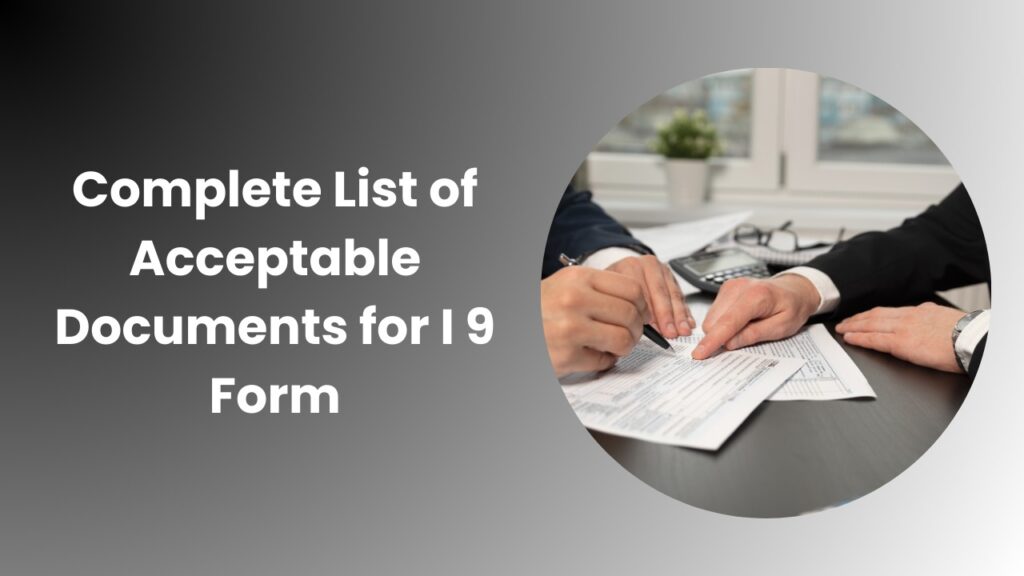The list of acceptable documents for I 9 form is essential for both employers and employees in the United States. When hiring new workers, employers must verify their identity and authorization to work in the country. This process is completed using Form I-9, a mandatory employment eligibility verification document required by the U.S. Citizenship and Immigration Services (USCIS). Understanding which documents are considered acceptable is critical, as submitting the wrong documents may delay hiring or even lead to penalties for the employer. In this guide, we will provide a comprehensive explanation of all the documents included in the I-9 lists and how they apply in different scenarios.
Why the I-9 Form Matters
The I-9 form was introduced as part of the Immigration Reform and Control Act of 1986. Its purpose is to ensure that every employee hired after November 6, 1986, is authorized to work legally in the United States. Employers are legally obligated to complete the form for every new hire, and employees must provide documentation proving both identity and work eligibility. Failure to comply with these regulations can result in fines, legal consequences, or loss of business credibility. The process may sound straightforward, but many employees and employers struggle to understand the wide range of documents that can be presented during verification.
List of Acceptable Documents for I 9 Form
The USCIS has divided the documents into three categories: List A, List B, and List C. Employees must either provide one document from List A, which proves both identity and work authorization, or they can present one document from List B (identity) and one from List C (employment authorization). Each of these categories includes several options, all of which are valid if presented in their original and unexpired form.
List A: Employment & Identity Verification Documents
U.S. Passport or U.S. Passport Card
A valid U.S. passport or passport card is one of the most common documents provided for the I-9 form. It serves as proof of both the employee’s identity and their authorization to work. The passport must be unexpired, and expired passports are not acceptable. This document is highly reliable since it is issued directly by the U.S. Department of State and confirms the individual’s citizenship status.
Permanent Resident Card (Form I-551)
Also known as the Green Card, the Permanent Resident Card allows individuals to live and work permanently in the United States. When presented for I-9 purposes, it confirms both identity and employment eligibility. Employers must check that the card is not expired and that the details match the employee’s other information. The Green Card has become a standard form of work authorization for lawful permanent residents.
Foreign Passport with an I-551 Stamp or MRIV
In some cases, an immigrant may not yet have a physical Green Card but can present a foreign passport that includes an I-551 stamp or a machine-readable immigrant visa (MRIV). This serves as temporary evidence of lawful permanent residence. Employers must carefully review the validity period on the stamp or MRIV to ensure the document is still valid.
Employment Authorization Document with Photograph (Form I-766)
The Employment Authorization Document (EAD) is issued to individuals who are not permanent residents or citizens but are legally authorized to work in the U.S. This card includes the individual’s photo, name, and eligibility category. It is widely used by asylum seekers, refugees, and certain nonimmigrant visa holders. For the I-9 form, this document covers both identity and work eligibility, making it a complete solution under List A.
Foreign Passport with Form I-94 or I-94A
Nonimmigrant visa holders often present a foreign passport along with Form I-94 or I-94A, which is issued by U.S. Customs and Border Protection. This combination confirms both identity and work authorization, but employers must check the class of admission and expiration date listed on the I-94. Depending on the visa type, additional documentation may sometimes be required.
List B: Documents That Establish Identity Only
Driver’s License Issued by a U.S. State
A state-issued driver’s license is one of the most common documents under List B. It must contain a photograph or identifying information such as name, date of birth, and physical description. While it establishes identity, it does not prove work eligibility, so it must be paired with a List C document.
Identification Card Issued by Federal, State, or Local Government Agencies
Apart from driver’s licenses, many states and government agencies issue official identification cards. These are widely accepted as identity verification documents. They are especially helpful for individuals who do not drive but still need official proof of identity.
School Identification Card with Photograph
For younger employees, especially those under the age of 18, a school identification card with a photograph may be used. While not as common as state IDs, this option allows students entering the workforce to meet identity verification requirements.
U.S. Military Card or Draft Record
Individuals who have served in the armed forces can present a U.S. military card or draft record as proof of identity. These documents are recognized by the federal government and carry a high level of reliability.
Military Dependent’s Identification Card
Dependents of U.S. military personnel may be issued a military dependent’s identification card. This card includes personal information and a photograph, making it a valid option for identity verification under List B.
List C: Employment Authorization Documents
Social Security Account Number Card
The Social Security card is one of the most frequently presented documents under List C. It confirms employment eligibility but not identity. Cards that are marked as “Not Valid for Employment” or “Valid for Work Only with DHS Authorization” are not acceptable unless accompanied by the required DHS authorization.
Certification of Birth Abroad (Form FS-545 or DS-1350)
This document is issued to U.S. citizens born outside the country. It verifies their citizenship status and therefore authorizes them to work in the United States. When paired with a List B document, it satisfies the I-9 requirements.
Original or Certified Copy of Birth Certificate
An original or certified copy of a birth certificate issued by a U.S. state, county, or municipality is also accepted. This document confirms U.S. citizenship and employment authorization. However, photocopies are not acceptable, and the document must be official and unexpired.
Native American Tribal Document
Native American tribal documents are another recognized option under List C. These documents prove eligibility to work in the United States when combined with a List B document for identity verification.
U.S. Citizen Identification Card (Form I-197)
Although less common today, the U.S. Citizen Identification Card is still considered valid for employment verification. It serves as proof of work authorization when combined with a suitable identity document.
Why Accuracy Matters When Completing the I-9 Form
Employers are required to ensure that all documents presented are valid, unexpired, and genuine. Accepting fraudulent or incorrect documents can expose a business to penalties and legal consequences. For employees, providing the right documentation ensures a smooth onboarding process and protects their rights as workers. Employers are not allowed to demand specific documents, but they must ensure that the chosen documents fall under the official list of acceptable documents for I-9 form as outlined by USCIS.
Common Mistakes to Avoid
Many employers make errors by either failing to complete the I-9 within the required three business days or by requesting specific documents, which is prohibited. Employees sometimes present expired documents or copies instead of originals, leading to delays. Staying informed about the rules and requirements helps avoid these issues and ensures compliance.
FAQs
What happens if an employee cannot provide acceptable documents?
If an employee cannot provide the required documents within the set timeframe, the employer cannot legally allow them to continue working. Employers must terminate the employment to remain compliant with federal law.
Are photocopies of documents acceptable for the I-9 form?
No. Only original and unexpired documents are accepted. Photocopies, even if notarized, are not valid for I-9 verification.
Can employers choose which documents employees must present?
No. Employers must allow employees to choose from the list of acceptable documents. Requesting specific documents can be considered discriminatory.
How long must employers keep completed I-9 forms?
Employers must retain I-9 forms for either three years after the date of hire or one year after the employee’s termination, whichever is later.
Can expired U.S. passports be used for the I-9 form?
No. Only unexpired passports or passport cards are acceptable. Expired documents do not meet the USCIS requirements.
Conclusion
The list of acceptable documents for I 9 form is a vital reference for both employers and employees in ensuring compliance with U.S. hiring laws. By understanding which documents establish identity, which confirm work authorization, and which provide both, the I-9 verification process becomes much smoother. Accuracy, timeliness, and compliance with USCIS rules protect both businesses and workers. Ultimately, completing the I-9 form correctly is not just a legal requirement but also a step toward maintaining integrity and fairness in the workplace.





